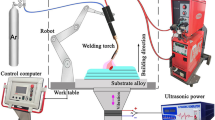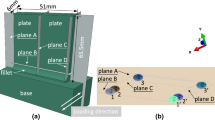Abstract
In this paper, the effect of vibration on microstructure and mechanical properties of CMT weld is studied. The results show that in the vibration laser welding joint, the penetration depth and residual height of the joint increase, and the weld pores are suppressed. Analysis of the microstructure of the welded joint by optical microscope and scanning electron microscope shows that vibration can refine the grains and reduce the width of the heat-affected zone, which is conducive to the optimization of the mechanical properties of the welded joint. The residual stress test results show that after vibration is applied, the residual stress of the welded joint is reduced, which is related to the grain refinement. In fatigue experiments, the morphology of the fatigue fracture after vibration is more regular and smooth, and the spacing between fatigue stripes of 1 mm is smaller than the spacing of fatigue stripes without vibration (2 mm). The fatigue strength of the sample with a vibration frequency of 1222 Hz can reach 84.61% of BM. The application of vibration can improve the fatigue performance of welded joints.












Similar content being viewed by others
References
SK Panigrahi, R Jayaganthan, Development of ultrafine grained Al–Mg–Si alloy with enhanced strength and ductility, Journal of Alloys & Compounds, 2009, 470(1-2), p 285-288.
S. Yan, Z. Zhu, C. Ma, Q. Qin, H. Chen, and Y. N. Fu, Porosity formation and its effect on the properties of hybrid laser welded Al alloy joints, The International Journal of Advanced Manufacturing Technology, 2019, 104(8), p 1-12.
A. Malikov, A. Orishich,N. Bulina,E. Karpov,M. Sharafutdinov, Effect of post heat treatment on the phase composition and strength of laser welded joints of an Al–Mg–Li alloy, Materials Science and Engineering A, 2019, 765, p 138302.
S. A. Ucsnik and G. Kirov, New possibility for the connection of metal sheets and fibre reinforced plastics, Materials Science Forum, 2011.
W. Wang, Q. Meng, and L. Niu, “Study on CMT Welding of Stainless Steel Railway Vehicle Body, 2014, 936, p 1769–1774.
A. Elrefaey, “Effectiveness of cold metal transfer process for welding 7075 aluminium alloys,2015, 20(4), p 280–286.
H. T. Zhang, J. C. Feng, and P. He, Interfacial phenomena of cold metal transfer (CMT) welding of zinc coated steel and wrought aluminium, Materials Science and Technology, 2008, 24(11), p 1346-1349.
H. Liu, S. Yang, C. Xie, Q. Zhang, and Y. Cao, Microstructure characterization and mechanism of fatigue crack initiation near pores for 6005A CMT welded joint, Materials Science and Engineering: A, 2017, 707, p 22-29.
T. Ma, J. Ge, Y. Chen, T. Jin, and Y. Lei, Observation of in-situ tensile wire-arc additively manufactured 205A aluminum part: 3D pore characteristics and microstructural evolution, Materials Letters, 2019, 237(FEB.15), p 266–269.
J. Gu, J. Ding, S. W. Williams, H. Gu, and P. Ma, The effect of inter-layer cold working and post-deposition heat treatment on porosity in additively manufactured aluminum alloys, Journal of Materials Processing Technology, 2016, 230, p 26-34.
Y. Liang, S. Hu, J. Shen, H. Zhang, and P. Wang, Effect of TIG current on microstructural and mechanical properties of 6061-T6 aluminium alloy joints by TIG-CMT hybrid welding, Journal of Materials Processing Technology, 2018.
N. Çömez, “EFFECT OF HEAT INPUT ON THE MICROSTRUCTURE , STRENGTH AND CORROSION BEHAVIOR OF SHEETS OF ALLOY AA6061 AFTER COLD METAL TRANSFER WELDING, Metal Science and Heat Treatment, 2019, 61, p 421–427.
A. Elrefaey and N. G. Ross, Microstructure and Mechanical Properties of Cold Metal Transfer Welding Similar and Dissimilar Aluminum Alloys. Acta Metallurgica Sinica, 2015, 28(006), p 715-724.
J Pang, S Hu, J Shen, P Wang, Y Liang, Arc characteristics and metal transfer behavior of CMT plus P welding process. Journal of Materials Processing Technology, 2016, 238, p 212-217.
J. Wang, C. Hsieh, H. Lai, C. Kuo, P. T. Wu, and W. Wu, The relationships between residual stress relaxation and texture development in AZ31 Mg alloys via the vibratory stress relief technique, Materials Characterization, 2015, 99, p 248-253.
W. Zhang, Q. H. Lu, P. L. Zhang, H. Yuan, and Y. Z. Bai, Vibration parameters optimum of 316L steel laser welding under high frequency micro-vibration condition, Materials Research Express, 2018.
B. Bagheri, M. Abbasi, and M. Dadaei, Mechanical Behavior and Microstructure of AA6061-T6 Joints Made by Friction Stir Vibration Welding, Journal of Materials Engineering and Performance, 2020, 29(2).
R. Tamasgavabari, A. R. Ebrahimi, S. M. Abbasi, A. R. Yazdipour, Effect of harmonic vibration during gas metal arc welding of AA-5083 aluminum alloy on the formation and distribution of intermetallic compounds, Journal of Manufacturing Processes, 2019, 49, p 413–422.
Z Qian, S Chumbley, T Karakulak, E Johnson, The Residual Stress Relaxation Behavior of Weldments During Cyclic Loading, Metallurgical and Materials Transactions A, 2013, 44(7), p 3147-3156.
Pandey, Chandan, Mahapatra, Manas Mohan, Kumar, Pradeep, A comparative study of transverse shrinkage stresses and residual stresses in P91 welded pipe including plasticity error, Archives of Civil and Mechanical Engineering, 2018, 18(3), p 1000-1011.
CW Kuo, CM Lin, GH Lai, YC Chen, YT Chang, W Wu, Characterization and Mechanism of 304 Stainless Steel Vibration Welding, Materials Transactions, 2007, 48(9), p 2319-2323.
H. Factors, J. Province, Z. Province, and Z. Province, High Frequency Vibration Weld Conditioning of 304 Stainless Steel Subjected to a Simulative Environment of Laser Welding, LASERS IN ENGINEERING, 2020, 45, p 367–380.
W. L. Dai, Effects of high-intensity ultrasonic-wave emission on the weldability of aluminum alloy 7075-T6, Materials Letters, 2003, 57(16/17), p 2447-2454.
ZL Wang, ZT Zheng, LB Zhao, YF Lei, K Yang, Microstructure evolution and nucleation mechanism of Inconel 601H alloy welds by vibration-assisted GTAW, International Journal of Minerals, Metallurgy, and Materials, 2018, 25(7), p 788-799.
G.A. Moraitis and G.N. Labeas, Residual Stress and Distortion Calculation of Laser Beam Welding for Aluminum Lap Joints, Mater. Process. Technol, 2008, 198(1–3), p 260–269
Lu Q , Chen L, Ni C. Effect of vibratory weld conditioning on welded valve properties. Mechanics of Materials, 2008, 40(7), p 565-574.
Jaap Schijve. Fatigue of Structures and Materials, Second Edition. Springer, 2009, p 15–19.
Funding
This research was funded by National Natural Science Foundation of China (52075317), Shanghai Science and Technology Committee Innovation Grant (19511106402).
Author information
Authors and Affiliations
Corresponding author
Ethics declarations
Conflict of interest
The authors declare no conflict of interest.
Additional information
Publisher's Note
Springer Nature remains neutral with regard to jurisdictional claims in published maps and institutional affiliations.
Rights and permissions
About this article
Cite this article
Zheng, P., Lu, Q., Zhang, P. et al. Effect of Vibration on Microstructure and Fatigue Properties of 6082 CMT-Welded Joints. Trans Indian Inst Met 74, 3217–3225 (2021). https://doi.org/10.1007/s12666-021-02383-7
Received:
Accepted:
Published:
Issue Date:
DOI: https://doi.org/10.1007/s12666-021-02383-7




